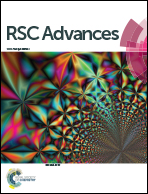(Y,Tb,Eu)2O3 monospheres for highly fluorescent films and transparent hybrid films with color tunable emission†
Abstract
(Y,Tb,Eu)2O3 monospheres (∼180 nm in diameter), calcined from the precursors synthesized via urea-based homogeneous precipitation, were employed as the building blocks for highly fluorescent films and as the dispersion fillers for transparent polymer films. The oxide spheres, consisting of ∼40 nm grains, simultaneously displayed the green emission of Tb3+ at 543 nm and the red emission of Eu3+ at 614 nm under 270 nm UV excitation, with the emission color finely tunable from red to yellow and then to green by increasing the Tb content. The efficiency of Tb3+ → Eu3+ energy transfer was found to be ∼51.7% for (Y0.95Tb0.02Eu0.03)2O3. Self-assembling the oxide monospheres produced close-packed phosphor films with transmittance ≥ 80% (600–850 nm region) and an emission intensity ∼6.8 times that of the powder form. Meanwhile, solution casting yielded transparent PVA films dispersed with the monospheres, which exhibit outstanding flexibility, high transmittance of ≥80% (450–850 nm region), and multi-color emission. The outcomes of this work may have wide implications for flexible luminescent devices and packaging and energy conversion materials.


 Please wait while we load your content...
Please wait while we load your content...